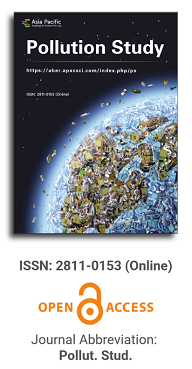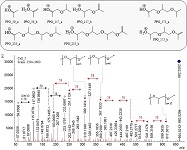
Asia Pacific Academy of Science Pte. Ltd. (APACSCI) specializes in international journal publishing. APACSCI adopts the open access publishing model and provides an important communication bridge for academic groups whose interest fields include engineering, technology, medicine, computer, mathematics, agriculture and forestry, and environment.

The (partial) replacement of synthetic polymers with bioplastics is due to increased production of conventional packaging plastics causing for severe environmental pollution with plastics waste. The bioplastics, however, represent complex mixtures of known and unknown (bio)polymers, fillers, plasticizers, stabilizers, flame retardant, pigments, antioxidants, hydrophobic polymers such as poly(lactic acid), polyethylene, polyesters, glycol, or poly(butylene succinate), and little is known of their chemical safety for both the environment and the human health. Polymerization reactions of bioplastics can produce no intentionally added chemicals to the bulk material, which could be toxic, as well. When polymers are used to food packing, then the latter chemicals could also migrate from the polymer to food. This fact compromises the safety for consumers, as well. The scarce data on chemical safety of bioplastics makes a gap in knowledge of their toxicity to humans and environment. Thus, development of exact analytical protocols for determining chemicals of bioplastics in environmental and food samples as well as packing polymers can only provide warrant for reliable conclusive evidence of their safety for both the human health and the environment. The task is compulsory according to legislation Directives valid to environmental protection, food control, and assessment of the risk to human health. The quantitative and structural determination of analytes is primary research task of analysis of polymers. The methods of mass spectrometry are fruitfully used for these purposes. Methodological development of exact analytical mass spectrometric tools for reliable structural analysis of bioplastics only guarantees their safety, efficacy, and quality to both humans and environment. This study, first, highlights innovative stochastic dynamics equations processing exactly mass spectrometric measurands and, thus, producing exact analyte quantification and 3D molecular and electronic structural analyses. There are determined synthetic polymers such as poly(ethylenglycol), poly(propylene glycol), and polyisoprene as well as biopolymers in bags for foodstuffs made from renewable cellulose and starch, and containing, in total within the 20,416–17,495 chemicals per sample of the composite biopolymers. Advantages of complementary employment in mass spectrometric methods and Fourier transform infrared spectroscopy is highlighted. The study utilizes ultra-high resolution electrospray ionization mass spectrometric and Fourier transform infrared spectroscopic data on biodegradable plastics bags for foodstuffs; high accuracy quantum chemical static methods, molecular dynamics; and chemometrics. There is achieved method performance |r| = 0.99981 determining poly(propylene glycol) in bag for foodstuff containing 20,416 species and using stochastic dynamics mass spectrometric formulas. The results highlight their great capability and applicability to the analytical science as well as relevance to both the fundamental research and to the industry.
Monitoring and studying rainfall runoff pollution from urban impervious surfaces
Vol 4, Issue 1, 2023
Download PDF
Abstract
Urban impervious surface rainfall runoff pollution is a significant component of non-point source pollution, with pollutants accumulating on these surfaces during dry periods being the primary source of contaminants in rainfall runoff. Using the first ten rainfall events of 2015 as a case study, impervious surfaces such as the roofs of teaching buildings, campus roads, and nearby main traffic roads within the university campus in southeastern Beijing were selected for field sampling and analysis of natural rainfall and rainfall runoff pollution. The findings indicate that the initial rainfall runoff pollution following winter is severe, with water quality falling below Class V. Subsequently, the pollution levels decrease; however, the severity of water pollution varies at different sampling locations. Notably, ammonia nitrogen concentrations are higher near building toilet exhaust outlets, and the presence of pervious surface facilities can mitigate runoff pollution. Based on the analysis and research findings, several recommendations for controlling and managing urban rainfall runoff pollution are proposed.
Keywords
References
- Zhao J. Pollution and control of urban surface runoff. Beijing: China Environmental Science Press; 2002.
- D Arcy B, Frost A. The role of best management practices in alleviating water quality problems associated with diffuse pollution. Science of the Total Environment. 2001; 265(13): 359-367.
- Apply as light Discussion on long-term pollution load model of urban rainfall runoff. Urban environment and urban ecology. 1993; 6(2): 610.
- Wang H, Liu M, Liu Q, et al. Initial scouring effect of urban storm runoff and runoff pollution management. Advances in water science. 2006; 17(2): 181185.
- Dong X, Du P, Li Z, et al. Parameter identification and verification of SWMM model in surface runoff simulation in urban impervious area. Environmental Science. 2008; 29(6): 1495-1501.
- Chen Q, Hu W, Zhang J. Research Progress on urban surface pollutant accumulation and rainfall runoff scouring process. Resources and environment of the Yangtze River Basin. 2009; 18(10): 992-995.
- Daly E, Bach PM, Deletic A. Stormwater pollutant runoff: A stochastic approach. Advances in Water Resources. 2014; 74: 148-155. doi: 10.1016/j.advwatres.2014.09.003
- Chow MF, Yusop Z. Sizing first flush pollutant loading of stormwater runoff in tropical urban catchments. Environmental Earth Sciences. 2014; 72(10): 4047-4058. doi: 10.1007/s12665-014-3294-6
- Zhao S, Zhou Y, Wang M, et al. Vacuum sampling device for rainwater runoff quality monitoring. Beijing: CN101196441; 2008.
- Wei F. Monitoring and analysis methods for water and wastewater, 4th ed. Beijing: China Environmental Science Press; 2002.
- Wang YF, Lin F, Pang WQ. Ammonium exchange in aqueous solution using Chinese natural clinoptilolite and modified zeolite. Journal of Hazardous Materials. 2007; 142(1-2): 160-164. doi: 10.1016/j.jhazmat.2006.07.074
Supporting Agencies
Copyright (c) 2023 Shuqi Zhao, Zhongzheng Wang, Yuwen Zhou, Weiming Yang, Lin Gao

This work is licensed under a Creative Commons Attribution 4.0 International License.

This site is licensed under a Creative Commons Attribution 4.0 International License (CC BY 4.0).
.jpg)
Beijing University of Technology, China



